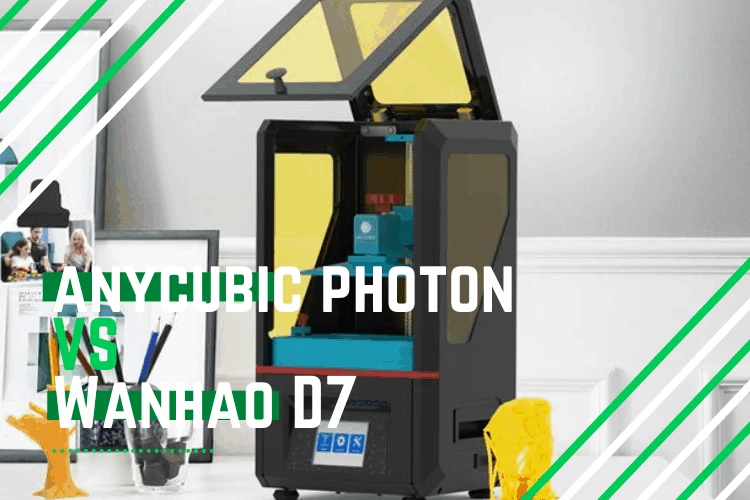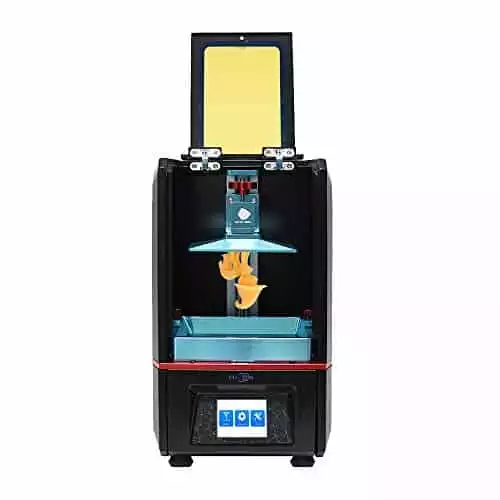- Intamsys FunMat HT Review: Will This Work for You? - June 2, 2022
- BCN3D Epsilon W50 Review: Worth the Price? - June 2, 2022
- Craftbot Flow Review – Is This 3D Printer Worth the Money? - April 23, 2022
Our Anycubic Photon vs Wanhao D7 comparison is going to put these two DLP resin 3D printers against each other.
These printers are a bit different than some of the other 3D printer models we have reviewed in the past. Resin DLP printers use liquid resin to produce detailed prints. They use a process called Vat Polymerization to print objects and the Anycubic Photon and Wanhao D7 are two popular printers in this category.
So, let’s find out how these 3D printers compare against each other and discover which one is the better 3D Printer to buy.
Bottom Line Up Front Summary: I personally prefer the better firmware support (and updates), built-in slicing software, better layer resolution range, and SD Card / USB connectivity offered by the Anycubic Photon here. While the Wanhao D7 is quite capable, it’s typically at least $100 more expesnive than the Anycubic Photon (current deals here).
Table of Contents
Main Differences Between Anycubic Photon vs Wanhao D7
The main differences between Anycubic Photon vs Wanhao D7 are:
- Anycubic Photon has its own dedicated software, whereas Wanhao D7 does not have one.
- Anycubic Photon has a build volume of 115 x 64 x 155mm, whereas Wanhao D7 has a build volume of 120 x 68 x 180mm.
- Anycubic Photon has both USB and SD Card connectivity, whereas Wanhao D7 only has USB connectivity.
- Anycubic Photon has a layer resolution of 25-100 microns, whereas Wanhao D7 has a layer resolution of 35 microns.
These two DLP 3D printers definitely fall into the budget category and you won’t be breaking the bank by purchasing either. How do they both shape up with their features?
Exploring Anycubic Photon and Wanhao D7 features
Printing
Printing objects and designs with a DLP 3D printer is a bit different than using the FDM 3D printers that we often review. They don’t use filament. With these two 3D printers you use a liquid resin that is cured by light to create objects.
The Anycubic Photon has a build volume of 115 x 65 x 155mm and a laser resolution of 25-100 microns. The prints with the Photon are extremely good. Even with the well known 3DBenchy test – which we use for our FDM 3D printers – the results were fantastic.
The Anycubic models came out to an extremely high quality and when you consider the cost of the Anycubic Photon, it represents real value for money. Even with complex layers on the print models, this printer was able to handle it with ease.
The Wanhao D7 offers similar results and it has a build volume of 120 x 68 x 180mm with a layer resolution of 35 microns. It uses the same technology to produce highly detailed prints and we also found that it handled the 3DBenchy test very well. There are a lot of printers that are much more expensive that don’t produce the high quality at the Wanhao D7 especially when it comes to complex models.
In terms of print quality, there isn’t much between these two printers. One thing to note is that because they are DLP 3D printers, the print time will generally be a good bit longer. This means they aren’t necessarily designed for mass-producing objects but given their cost, they are certainly ideal for home use.
Post-processing
Both of these printers are aimed at experienced people and they aren’t made or marketed at novices and beginners. This is due to the post-processing tasks that you need to carry out.
With many other affordable 3D printers that use a filament, they can often be a ‘plug and play’ device. While they take some getting used to, most hobbyists can get the basics and produce good prints in no time.
With both the Wanhao D7 and the Anycubic Photon, you need to do something called post-processing. This involves cleaning your printed objects with isopropyl alcohol and the resin that is used when printing the objects is hazardous as well. The post-processing is the same for both of these printers and it is something to keep in mind because it adds an extra task before your models are ready to go.
Cleaning
These printers will require a bit more cleaning than many others due to the processes they use to create objects.
You need to clean the Wanhao D7 and the Anycubic Photon before and after you print. This can be a slightly arduous task. It involves pulling out the resin vat and removing any solid parts. The build plate needs to be cleaned each time too.
Both of these 3D printers require more cleaning than the majority of the FDM models. It is something to keep in mind because it does add to the time to print things off. It is also important that you wear all the required safety equipment when printing, post-processing, and cleaning.
Software
With the Anycubic Photon, you will get slicing software provided with your purchase. It is actually one of the easier pieces of software to use with these kinds of printers. It can be a bit limiting with the settings you can change – the adjustable settings including normal exposure time, layer thickness, off time, and bottom and exposure time – but there are preset settings available too. The software allows you to modify things such as scaling and rotating models and it works pretty quickly too.
One thing that is a bit of a downside is the fact that you don’t get much explanation or descriptions of the settings.
There is no dedicated software with the Wanhao D7 but you do get access to Creation Workshop. It isn’t that easy to find the actual download file and many people have complained that it isn’t readily available on their website. You can use other slicer software with this 3D printer but this is the one that you get access to with the product.
In many ways, the lack of a dedicated software with the Wanhao is more indicative of the lack of specialized software with DLP printers. There certainly aren’t as many good options as there are for the FDM 3D printers.
Specifications for Anycubic Photon and Wanhao D7
| Anycubic Photon | Wanhao D7 |
| Build Volume: 115 x 65 x 155mm | Build volume: 120 x 68 x 180mm |
| Software: Has its own dedicated slicing software | Software: Doesn’t have its own slicing software. You get access to Creation Workshop |
| Connectivity: USB, SD Card | Connectivity: USB |
| Layer Resolution: 25-100 microns | Layer Resolution: 35 microns |
Dead simple to set-up, comes pre-assembled, intuitive touch-screen and exceptional level of detail. This machine empowers CREATORS, without expecting you to be a mechanic. The small - but precise - print bed is perfect for miniatures.
Comparing Anycubic Photon and Wanhao D7 pricing
These two models of 3D printers certainly come in at the budget end of the spectrum and that is very much the market they are aimed at.
That isn’t to say that because you pay a budget price you get budget quality. As we’ve shown when looking at the printing features above, both produce great prints even with complex models.
So, how do they compare in cost?
The Anycubic Photon really isn’t expensive at all and even when you add in the cost of the resin, it is still coming in very cheap compared to many other models. You will need to add resin which will add to the cost (it is more expensive than filament) but overall it is still very cheap.
The Wanhao D7 3D printer is a bit more expensive. Like the Anycubic Photon, you’ll need to pay for resin as well to produce your prints. This is a bit more than filament so it is something to factor in when you are looking at these 3D printers. That being said, the cost of the Wanhao D7 is still a lot lower than many other models on the market. Even though it is pricier than the Anycubic Photon, it is still an inexpensive DLP 3D printer.
Anycubic Photon vs Wanhao D7 ease of use
Neither of these 3D printers are made for beginners. This is down to the fact that using DLP printers and working with resin is a lot more hazardous than using filament.
The toxic resins require you to use various safety products such as goggles, gloves, and masks. You really don’t want this stuff to touch your skin and even the post-processing and cleaning of the printer isn’t something for novices to do.
In terms of the actual printing of the objects, it is a bit trickier than other 3D printers and that goes for both the Anycubic Photon and the Wanhao D7. If you are a beginner or even if you have a bit of experience with 3D printing, you might find the process a bit cumbersome and long-winded.
That being said, the software isn’t that hard to use. The software with the Anycubic Photon is very easy to operate and the fact that it is dedicated software adds to this. The Wanhao D7 doesn’t have its own software and the one provided is fairly straightforward as well.
Overall, both of these printers are a bit more complex than your average model but that is as much down to the fact that they use resin than anything else.
What support is available for the Anycubic Photon and Wanhao D7
As both of these 3D printers are a bit more complicated, you’ll need to have some decent support options available.
You can find the firmware and software downloads easily on the Anycubic website and they are handily on the actual product page. The manual can be found here as well. They have a contact form on their website as well as a dedicated after-sales support portal you can log into. Overall the support isn’t fantastic but it isn’t terrible either. It is easy enough to get in contact and the software, firmware, and manuals are easily found on the product page.
Wanhao’s support isn’t that great. The actual support section of their website is completely empty. You can find some FAQs, manuals for your 3D printer as well as other information on the product pages. It was difficult to locate the software as well. They don’t offer great options for getting in contact. Whether that is down to where they are based I’m not sure but there are manufacturers that are much easier to get in contact with.
Pros and Cons
Anycubic Photon
Pros
- Very affordable DLP 3D printer that products high-quality models
- Isn’t for beginners but easy enough for experienced users
- Good size of the printer and won’t take up a lot of space
- Dedicated slicer software which is easy to use
- Has some support options and manual/downloads straightforward to find
Cons
- Pre-print and post-processing can be time-consuming
- Need various safety equipment due to working with toxic materials
Wanhao D7
Pros
- Low-cost DLP 3D printer that is much cheaper than many other models
- Produces very good resin prints even with complex designs
- Well designed and won’t take up too much space
- Easy to use for those that are experienced with DLP printers
Cons
- Like all DLP printers, printing, cleaning, and post-processing takes time
- Doesn’t have dedicated software
- Support options and the website isn’t great
Are there any alternatives?
Creality LD-002R LCD Resin 3D Printer

If you want an alternative to the Anycubic Photon and the Wanhao D7, the Creality LD-002R LCD Resin 3D Printer is definitely an option. With a 119 X 65 X 160mm print volume and ability to print off high-quality models, it is a very good entry-level option.
People who are getting to grips with DLP 3D printers will find this one from Creality ideal. It is also priced in and around the same bracket as the Anycubic Photon and the Wanhao D7 (albeit a bit closer to the Anycubic Photon) so you won’t be shelling out a lot of money for this printer. The active carbon air filtering system is a good addition as it cuts down on the smell from the resin too.
Sparkmaker SLA 3D Resin Printer

For anyone that wants a smaller build size as well as a cheaper price, the Sparkmaker SLA 3D Resin Printer is a good resin 3D printer to buy. It has a build volume of 98mm x 55mm x 125mm and like all resin printers, the usual caveats apply around safety and working with toxic resin.
Again, this isn’t really a printer for a complete novice but it is an easy to use the device. You don’t need to have a ton of experience to operate the Sparkmaker SLA 3D Resin Printer but it isn’t a ‘plug and plays’ machine. That being said, this is a great resin printer if you want a smaller build volume and a cheaper price.
Dead simple to set-up, comes pre-assembled, intuitive touch-screen and exceptional level of detail. This machine empowers CREATORS, without expecting you to be a mechanic. The small - but precise - print bed is perfect for miniatures.
FAQs About Anycubic Photon and Wanhao D7
The difference between a resin DLP 3D printer and a FDM 3D printer is that they don’t use filament. These printers use a liquid resin that is cured by light to create objects.
Printing will be slower with these two models and an FDM 3D printer. This is because the process takes longer and you also need to clean the machine more often. Post-processing also has to be carried out on the printed models which can add more time.
Both the Anycubic Photon and Wanhao D7 are manufactured in China.
Wanhao don’t have their own slicing software but you do get access to Creation Workshop. Their website isn’t that easy to find things and the information is patchy so accessing can be a bit difficult.
Yes. Both of these 3D printers come with a warranty. You can find information on the warranty for the Anycubic Photon on their website as different parts have different warranty cover and you get a 1-year warranty with the Wanhao D7.
Verdict: Anycubic Photon vs Wanhao D7 – Which is better?
If you are looking for a budget DLP resin 3D printer and want to know what one to choose between the Anycubic Photon and the Wanhao D7, I’m going to let you know my preference.
Bottom Line Summary: Both of these printers produce great results. It is really hard to try and distinguish between the two but I am going to choose the Anycubic Photon.
The actual process of using resin can be cumbersome and it definitely involves much more work than using filament on an FDM 3D printer. There isn’t any real difference in the cleaning/printing process between these printers and also the print quality is very similar. So, why did I choose the Anycubic Photon?
Well, they have their own dedicated slicing software. It might not seem like a massive deal but it does make a difference in my opinion. The Photon also has a bigger layer resolution range and even though the build volume is a bit smaller, they have SD card and USB functionality.
The Anycubic website is also a lot better and more advanced. It is much easier to find downloads for firmware, software and a manual on the product page. Their support options are clearer than Wanhao too.
Overall you can’t really go wrong with either of these 3D printers. They are powerful, budget-friendly, and produce great results. The Anycubic Photon is just better and more user friendly overall and that’s why I would choose the Photon over the Wanhao D7.
Dead simple to set-up, comes pre-assembled, intuitive touch-screen and exceptional level of detail. This machine empowers CREATORS, without expecting you to be a mechanic. The small - but precise - print bed is perfect for miniatures.
Further Reading on Comparable 3D Printers:





